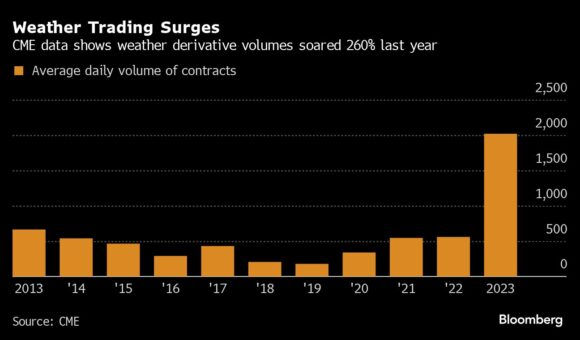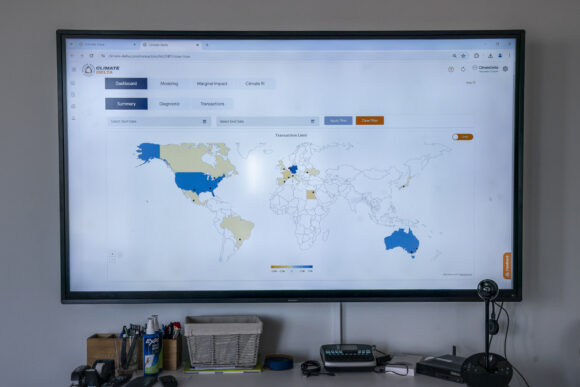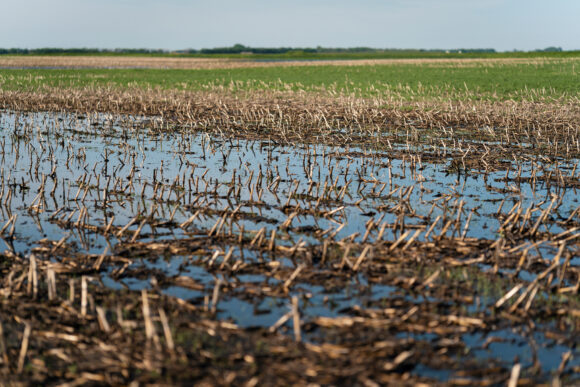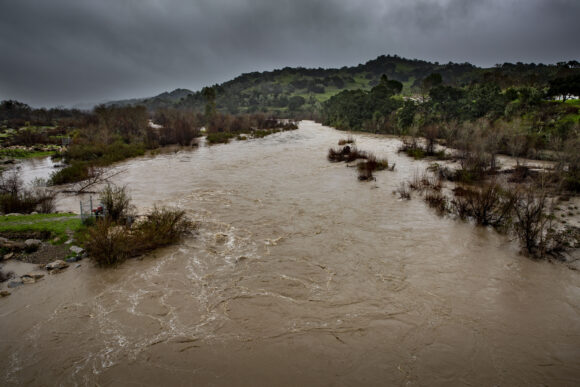Marty Malinow’s mom never could get her head around what her son did for a living. To friends, she said he was “a stockbroker that does something with the weather.” Malinow couldn’t really object — he knew most people had no clue about financial contracts based on things like sunshine, rainfall and wind.
That’s beginning to change. Against a backdrop of rising climate volatility and social shifts, demand for weather derivatives is surging. Average trading volumes for listed products jumped more than 260% in 2023, according to the CME Group, with the number of outstanding contracts currently 48% higher than a year ago. And that publicly traded corner could make up as little as 10% of all activity, according to industry estimates; outstanding derivatives may be worth as much as $25 billion based on notional value.
“There’s a lot more trajectory to our business right now,” says Malinow, the founder and chief executive officer of advisory firm Parameter Climate. “The heightened fragility from direct weather volatility, supply-chain issues, inflation, geopolitics. It means weather can eat up a bigger part of the bottom line now.”

Wall Street’s better-known weather bets, catastrophe bonds, are also riding high following a year of bumper returns. But this boom is playing out in derivatives, which provide a different kind of hedge: Protection from less severe but more common meteorological threats. While a cat bond may pay out if a 100-year storm tears through a community, a weather derivative can compensate a tourism business if there are too many rainy days, or a farmer if a hot summer stresses her crops.

In response to the soaring demand for its listed derivatives — all based around temperatures — the CME expanded its offerings last year. Now traders and companies can buy options that cover Philadelphia, Houston, Boston, Burbank, Paris and Essen, Germany, in addition to established contracts covering locations like Chicago, New York, London and Tokyo. In their August debut, 5,000 “Heating Degree Day” options (tied to how cold it gets) traded for Essen alone.
“We’re in market version 3.0,” says Scott Klemm, chief revenue officer at Arbol Inc., which structures products for companies looking to hedge their weather risk. “The growth trajectory where we are now has way more runway, way more upside.”
Facing the Threat
Part of the jump in demand is driven by corporations newly confronting their exposure to the elements. In some cases, it’s because their operations have already been impacted, in others because they’re responding to investor and consumer pressures. In many jurisdictions, regulators are beginning to compel companies to quantify just how much of a threat the weather is to their business.
Most large and listed European companies are now required to disclose what they see as risks and opportunities from environmental factors. In the US, the Securities and Exchange Commission finalized rules in March that would make it mandatory for companies to publish information describing the climate-related risks that may impact their business, as well as any mitigation steps they’ve taken.
“All of these companies have weather risks that they’re not hedging, and now they have to deal with it,” says Nicholas Ernst, managing director of climate derivatives at BGC Group, a market intermediary. “We’re starting to move into this much larger financial market.”
The SEC plans remain the subject of intense debate, with the watchdog facing lawsuits not only from groups challenging its authority to introduce such regulation, but also from those who say the rules don’t go far enough. Regardless, the expectations of investors and other stakeholders mean there is increasing pressure on businesses to identify and address their risks.

It has simply gotten much harder for corporations to dismiss the issue in a way they have historically, reckons Arbol’s Klemm. “How many times did we read an earnings report or listen to an earnings call and the officers of the firm said, ‘You know, it was, it was a really wet, wet spring. It impacted our bottom line.’ Shoulder shrug, move on?” he says.
Malinow, who describes himself as the éminence grise of the market, was an early recruit to one of the world’s first weather-derivatives desk at Enron Corp. In more than a quarter century helping companies hedge their exposure to Mother Nature, he’s created contracts for everything from cold cattle (shivering burns more calories, which can mean less meat) and subsea power cables (they can’t conduct electricity well when their connection points get warm) to turkey mortality (birds die if it’s too hot).
But historically weather derivatives have mostly been used to cushion energy companies from fluctuations in demand caused by shifting temperatures. Power suppliers face clear and predictable risks: If a summer is cooler than expected, people won’t use air conditioners as much, and in a mild winter, heating demand might wane. Options based on temperature indexes can help offset any hit to their income.
For example, Star Group LP, a US-based supplier of home heating and air conditioning products and distributor of heating oil, uses hedges to help mitigate the impact of warm weather on cash flows. According to its financial statements, the contracts meant the company could receive up to $12.5 million if temperatures experienced during the coverage period of November through March crossed certain thresholds. After receiving payouts in recent financial years — including the full benefit in 2023 — the maximum payment has risen to $15 million for the contracts payable in 2025. The firm declined to comment.
Energy companies are also contributing to the current boom, albeit for fresh reasons. Solar panels, wind farms and hydropower generation are at the mercy of sunlight, wind speed and rainfall, respectively, meaning as producers shift to renewable sources they face new supply-side fluctuations on top of more traditional swings in consumption.
“That intermittency, along with the volatility of the natural gas market, has reinvigorated the weather-derivative space,” says Klemm at Arbol, which recently raised $60 million in a funding round to help fuel its expansion.
Malinow’s firm, Parameter Climate, works with companies keen to insure against these kinds of threats. That includes energy suppliers with their increasingly complex needs, as well as businesses that are considering weather hedges for the first time.
“There are other verticals out there with embedded weather risks that have yet to be unpicked, like onshore and offshore construction, agriculture and transportation,” he says. “There are a lot of companies that don’t even know how to begin to address their risk, and this will contribute to future market growth as they learn.”
New Tech
Advances in meteorological science and technology are giving rise to new and more sophisticated products. A classic weather trade might look like the one used by Star Group, but Syngenta, a multinational producer of seeds and pesticides, has hit on another way to deploy derivatives to enhance its offering to farmers.
Under its AgriClime program, Syngenta pledges a cash refund for up to 30% of a farmer’s purchase of certain crops if nature fails to provide the right growing conditions. So when heavy rainfalls threaten a barley harvest, for example, growers won’t be wiped out. That happened in the UK’s last planting season, and Syngenta says it made payouts to 99% of its hybrid barley customers.

The program is underpinned by derivatives. The exact structure of such contracts can vary (calls, puts and swaps are common variants), but typically they involve a buyer with weather risk — say, Syngenta — paying a premium to a seller who takes on that risk, promising a payout if certain meteorological measures are met. Insurance companies and sometimes hedge funds or other investment firms usually take the other side of the trades.
Syngenta says its program has proved a wild success. The AgriClime offer now covers a range of crops over more than 50,000 farms in 17 countries, according to Peter Steiner, the firm’s global head of weather and credit risk management.
“In many countries and areas, the climate got more volatile, weather risk became more difficult,” he says. “Syngenta AgriClime has proven that derivatives aren’t only effective for hedging company balance sheets, but that with the right technology and processes, they can protect multiple individual end users.”
Old Doubts
The growth of the weather market risks resurrecting an unanswered question of moral hazard: Does mitigating the financial impact of weather on corporations reduce their incentive to tackle their own contributions to man-made climate change? As one academic wrote in 2014, that “could increase the negative impact of the actions of those benefiting from these markets, at the expense of the majority and particularly those most vulnerable to climate change.”
Industry practitioners insist it’s a net positive, pointing to the market’s key role in helping fund renewable power projects, as well as protecting communities from climate challenges. “We’re able to ease the pain of some of these massive global problems,” says Dave Whitehead, co-CEO for Speedwell Climate, which provides the detailed meteorological data underpinning many weather trades. “We’re not solving the problems, but we’re creating situations where governments can fund rebuilding projects in the event of a disaster.”
It’s the more practical concerns that have held back the growth of weather trading thus far. The industry took a big hit during the financial crisis, with one study recording a 50% drop in the notional value of the weather-derivatives market as risk takers withdrew from more exotic, harder-to-hedge positions.
Weather derivatives are also highly specific — often a bespoke contract based on localized risks — and frequently short term. That severely curtails secondary trading activity. There’s also “basis risk,” which refers to a derivative’s effectiveness as a hedging tool. In the case of the weather market, basis risk can lie in geography (if the point of measurement deciding a contract isn’t close enough to the location seeking protection), in the timing of when the contract is effective, and in the fact that the payout isn’t tied to the actual economic impact that occurs.
For all the challenges, market players now seem as optimistic as they’ve ever been.
Maria Rapin, the CEO of Nephila Climate, oversees an investment strategy that steers capital to businesses and institutions facing increased financial exposure to weather volatility. Rapin says that 20 years ago, eyes would glaze over when she talked about her work at a major insurance firm structuring catastrophe bonds and helping transfer weather risk.
“Now people are like, ‘wow, you’re at the center of everything,'” she says. “This is mainstream.”
Top photograph: Heavy rain caused the Santa Ynez River to flood the farming region north of Santa Barbara, California, on Feb. 19, 2024. Photo credit: George Rose/Getty Images
Was this article valuable?
Here are more articles you may enjoy.


 Americans Hit the Road as Economic Fears Discourage Flying
Americans Hit the Road as Economic Fears Discourage Flying  Flyers Avoiding Newark Airport Over Safety Fears
Flyers Avoiding Newark Airport Over Safety Fears  Spain Blackout Shows Need for Batteries in Renewable-Heavy World
Spain Blackout Shows Need for Batteries in Renewable-Heavy World  Air Traffic Control Overhaul Seeks Upgraded Towers, Radar
Air Traffic Control Overhaul Seeks Upgraded Towers, Radar 